*NURSING > HESI > HESI Management of Care - Questions/ Latest Questions and Complete Solutions/ Already Graded A (All)
HESI Management of Care - Questions/ Latest Questions and Complete Solutions/ Already Graded A
Document Content and Description Below
HESI Management of Care - Questions (A Graded) Latest Questions and Complete Solutions A client with leukemia is being considered for a bone marrow transplant. The healthcare team is discussing the ri... sks and benefits of this treatment and other possible treatments with the goal of inflicting the least possible harm on the client. Which principle of healthcare ethics is the team practicing? Justice Fidelity Nonmaleficence Autonomy Rationale: Nonmaleficence is the avoidance of hurt or harm. Remember that in healthcare ethics, ethical practice involves not only the will to do good but also the equal commitment to do no harm. Healthcare professionals try to balance the risks and benefits of a plan of care while striving to do the least possible harm. Justice refers to fairness and equity and ensuring fair allocation of resources, such as nursing care for all clients. Fidelity is the keeping of promises made to clients, families, and other healthcare professionals. Autonomy refers to a person’s independence and represents an agreement to respect another’s right to determine his or her course of action. Test-Taking Strategy: Focus on the subject - the ethical principle being utilized. Recall the definition of each item in the options. Note the relationship of the words “least possible harm” in the question and the definition of nonmaleficence. Review: principles of healthcare ethics. Reference: Potter, P., & Perry, A. (2009). Fundamentals of nursing (7th ed., p. 314). St. Louis: Mosby. Cognitive Ability: Applying Client Needs: Safe and Effective Care Environment Integrated Process: Nursing Process/Implementation Content Area: Ethical/Legal Giddens Concepts: Celluar Regulation, Ethics HESI Concepts: Advocacy/Ethical/Legal Issues, Cellular Regulation Question 2 1 / 1 pts Which action by the nurse represents the ethical principle of beneficence? The nurse provides equal amounts of care to all assigned clients on the basis of illness acuity. The nurse follows a plan of care designed to relieve pain in a client with cancer. The nurse upholds a client’s decision to refuse chemotherapy for lung cancer. The nurse administers an immunization to a child even though it may cause discomfort. Rationale: Beneficence is taking action to help others. Although administration of a child’s immunization might cause discomfort, the benefits of protection from disease outweigh the temporary discomfort. Fidelity is keeping promises made to clients, families, and other healthcare professionals. Autonomy is a person’s independence. Respecting another’s autonomy means that you are agreeing to respect that person’s right to determine his or her course of action. Justice refers to fairness and equity, including fair allocation of resources, such as nursing care for all clients. Test-Taking Strategy: Focus on the subject, beneficence. Recalling that beneficence refers to taking action to help others will direct you to the correct option. Review: the principles of healthcare ethics . Reference: Potter, P., & Perry, A. (2009). Fundamentals of nursing (7th ed., p. 314). St. Louis: Mosby. Cognitive Ability: Applying Client Needs: Safe and Effective Care Environment Integrated Process: Nursing Process/Implementation Content Area: Ethical/Legal Giddens Concepts: Ethics, Immunity HESI Concepts: Advocacy/Ethical/Legal Issues, Immunity The nursing instructor asks a student to name an example of false imprisonment. Which situation reflects a violation of this client right? Threatening to give a client a medication against his or her will Telling the client that he or she may not leave the hospital Observing the provision of care to the client without the client’s permission Performing a procedure without consent Rationale: Telling a client that he or she may not leave the hospital constitutes false imprisonment. Performing a procedure without consent is an example of battery. Threatening to give a client a medication against his or her will is assault. Invasion of privacy takes place with unreasonable intrusion into an individual’s private affairs. Observing the provision of care to a client without the client’s permission is an example of invasion of privacy. Test-Taking Strategy: Focus on the subject, an example of false imprisonment. Note the relationship of the subject and the words in the correct option. Review: the concept of false imprisonment. References: Cherry, B., & Jacob, S. (2008). Contemporary nursing issues: Trends & management (4th ed., pp. 175, 176). St. Louis: Mosby. Zerwekh, J., & Claborn, J. (2009). Nursing today: Transition and trends (6th ed., p. 424). Cognitive Ability: Evaluating Client Needs: Safe and Effective Care Environment Integrated Process: Teaching and Learning Content Area: Ethical/Legal Giddens Concepts: Health Care Law, Leadership HESI Concepts: Advocacy/Ethical/Legal Issues, Health Policy/Systems—Health Care Law The nurse and an unlicensed assistive personnel (UAP)enter a client’s room to provide care and find the client lying on the floor. Which action should the nurse take first? Ask the nursing assistant to assist in getting the client back to bed Contact the unit secretary on the intercom and ask that the client’s health care provider be called Check the client’s level of consciousness and vital signs Ask the nursing assistant to complete an incident report Rationale: When a client sustains a fall, the nurse must first assess the client. The nurse should check the client’s level of consciousness and vital signs and look for any bruises or injuries sustained in the fall. If the nurse determines that the client has not sustained any injuries and that it is safe to move the client, the nurse should ask the UAP to assist in getting the client into bed. The nurse should then contact the health care provider and file an incident report. Test-Taking Strategy: Note the strategic word “first.” Use the steps of the nursing process to answer the question. The correct option is the only one that addresses assessment. Remember to always assess the client first if a client sustains a fall. Review: client injuries and procedures for filing incident reports . References: Ignatavicius, D., & Workman, M. (2010). Medical-surgical nursing: Patient– centered collaborative care (6th ed., p. 180). St. Louis: Saunders. Potter, P., & Perry, A. (2009). Fundamentals of nursing (7th ed., p. 403). St. Louis: Mosby. Cognitive Ability: Applying Client Needs: Safe and Effective Care Environment Integrated Process: Nursing Process/Implementation Content Area: Delegating/Prioritizing Giddens Concepts: Mobility, Safety HESI Concepts: Mobility, Safety Which action exemplifies the use of evidence-based practice in the delivery of client care? Taking a rectal temperature from a client for whom bleeding precautions have been instituted Encouraging a client to take an herbal substance to treat his insomnia Advising a client to agree to the treatment recommended by her health care provider Donning sterile gloves to change an abdominal wound dressing Rationale: Evidence-based practice is an approach to client care in which the nurse integrates the client’s preferences, clinical expertise, and the best research evidence to deliver quality care. Donning sterile gloves to change an abdominal wound dressing reflects evidence-based practice, because it prevents the entrance of harmful bacteria into the wound. The remaining options do not reflect evidence-based practice. Taking an herbal substance could be harmful to some clients. It is nontherapeutic for a nurse to advise a client to agree to a treatment. Because of the risk of injury to the rectal mucosa, rectal temperature-taking is avoided in the client for whom bleeding precautions have been instituted. Test-Taking Strategy: Read each option carefully, focusing on the subject, evidence- based practice. Recall the definition of evidence-based practice and note the words “sterile gloves” in the correct option. Review: the situations that reflect evidence-based practice . Reference: Potter, P., & Perry, A. (2009). Fundamentals of nursing (7th ed., pp. 54-60). St. Louis: Mosby. Cognitive Ability: Applying Client Needs: Safe and Effective Care Environment Integrated Process: Nursing Process/Implementation Content Area: Leadership/Management Giddens Concepts: Evidence, Safety HESI Concepts: Evidence-Based Practice/Evidence, Safety [Show More]
Last updated: 1 year ago
Preview 1 out of 88 pages
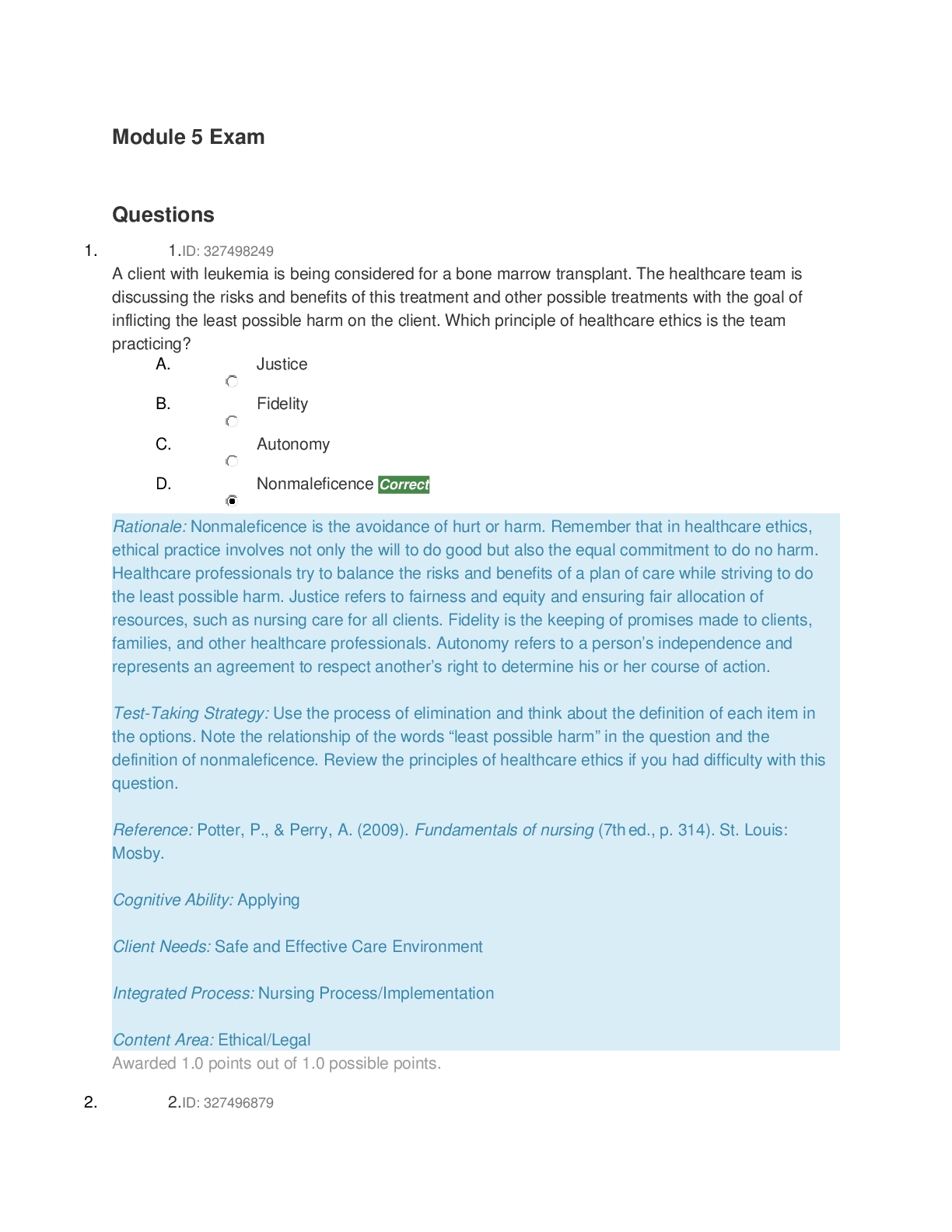
Reviews( 0 )
Document information
Connected school, study & course
About the document
Uploaded On
Jun 07, 2021
Number of pages
88
Written in
Additional information
This document has been written for:
Uploaded
Jun 07, 2021
Downloads
1
Views
38


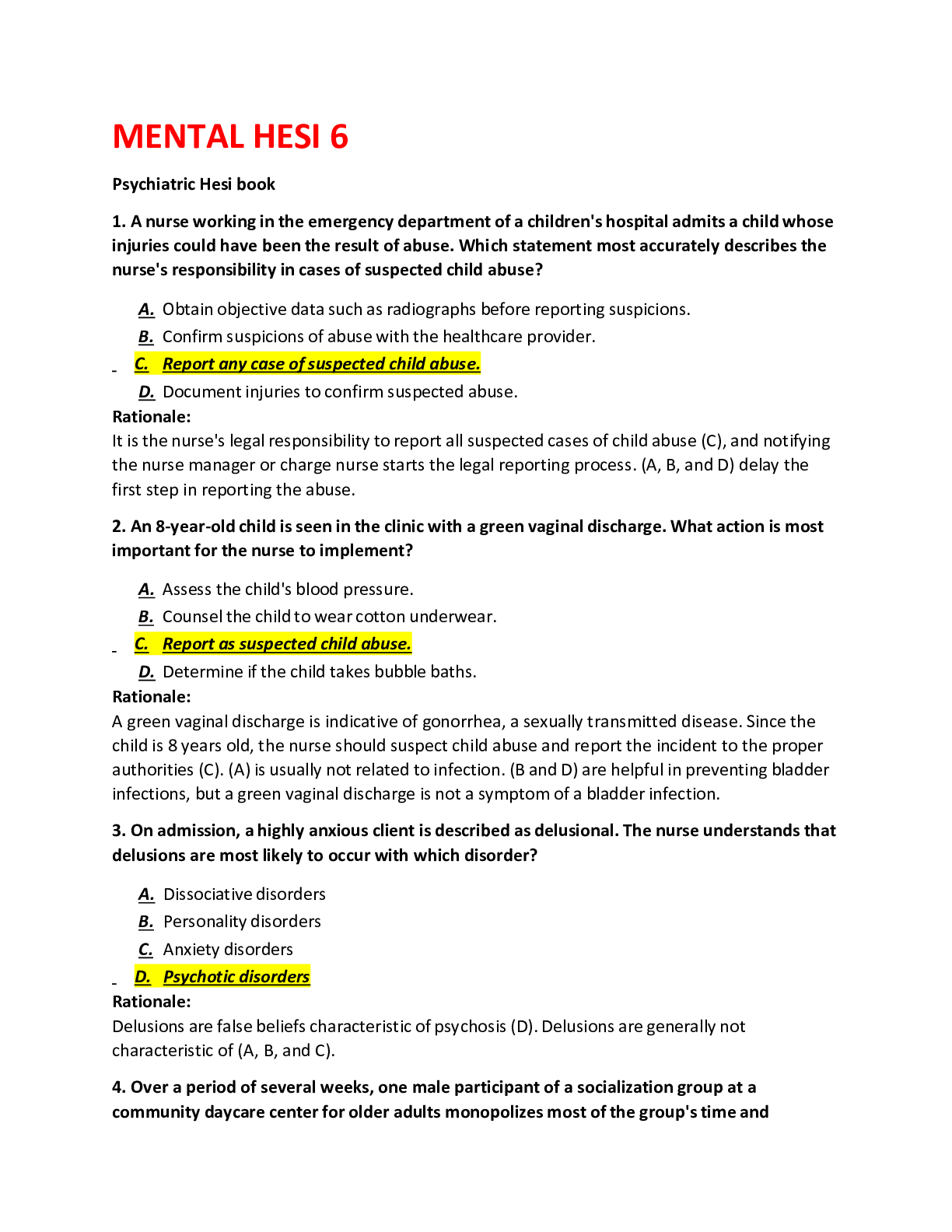
.png)
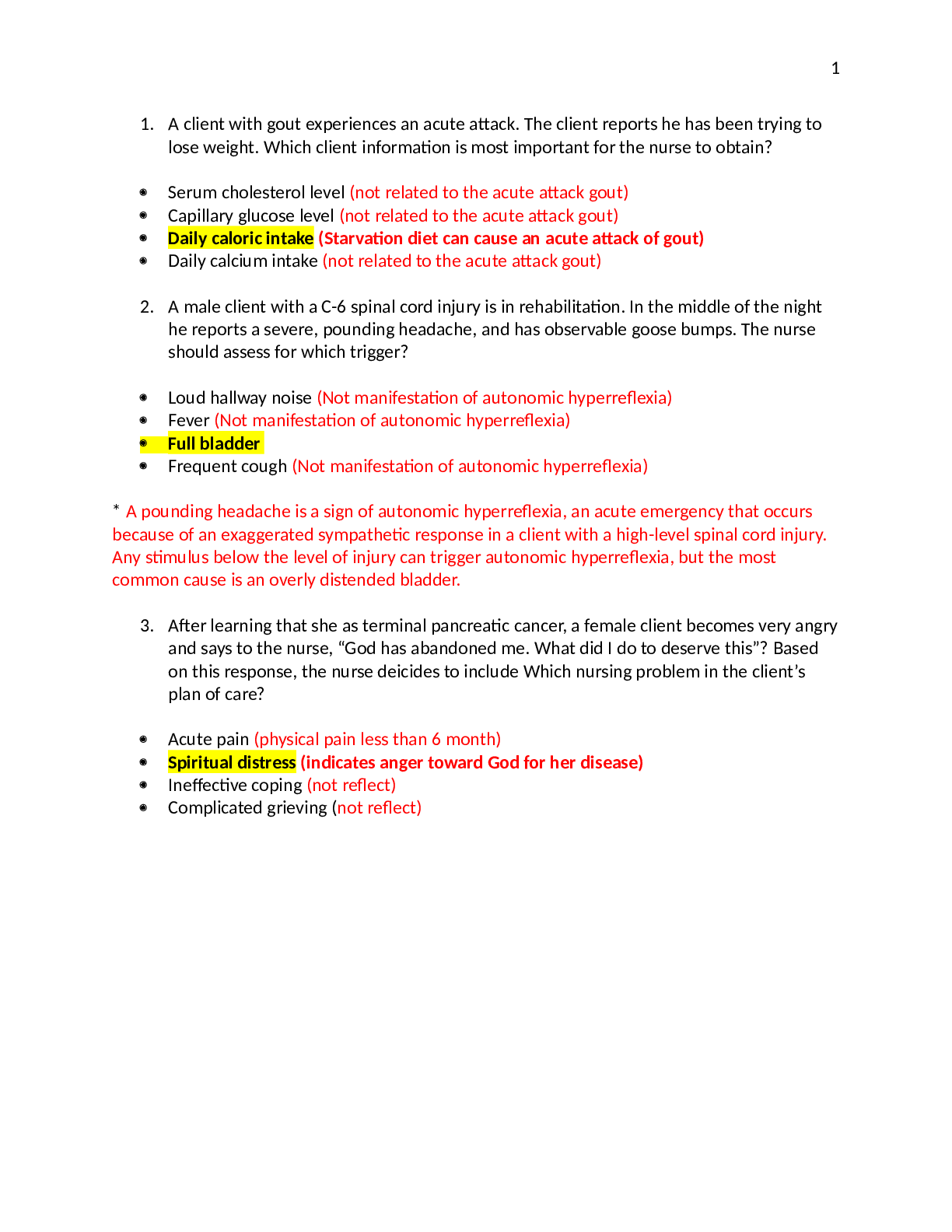
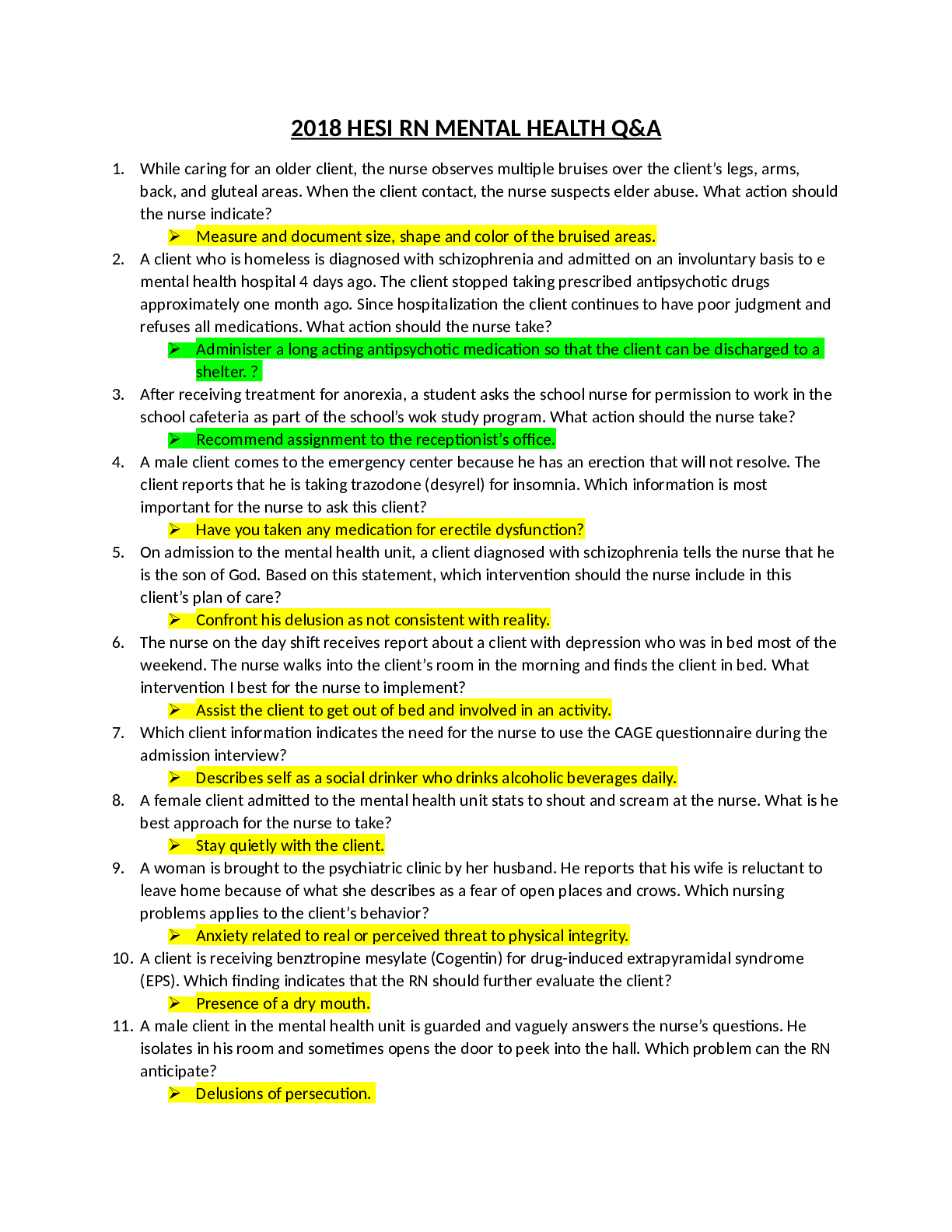
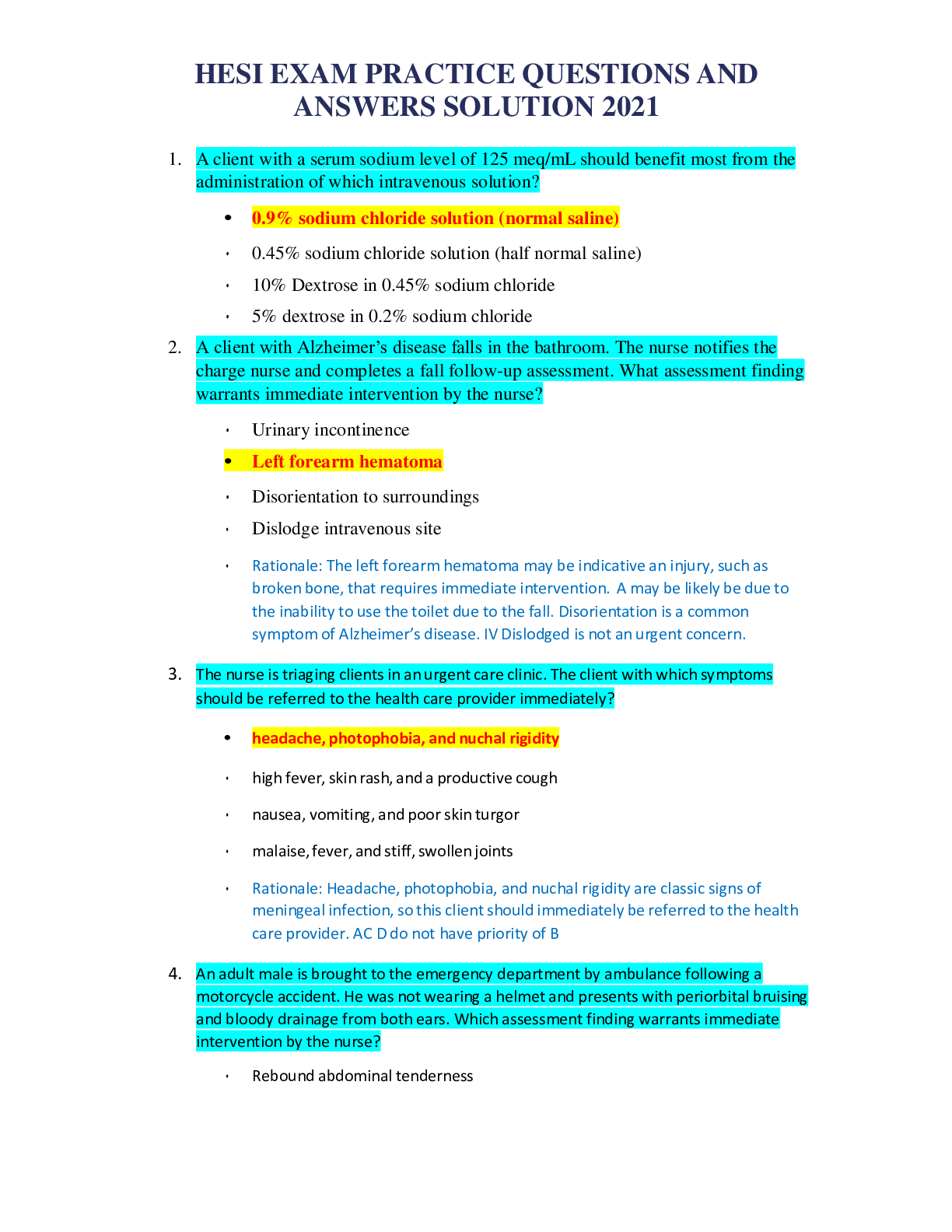
.png)

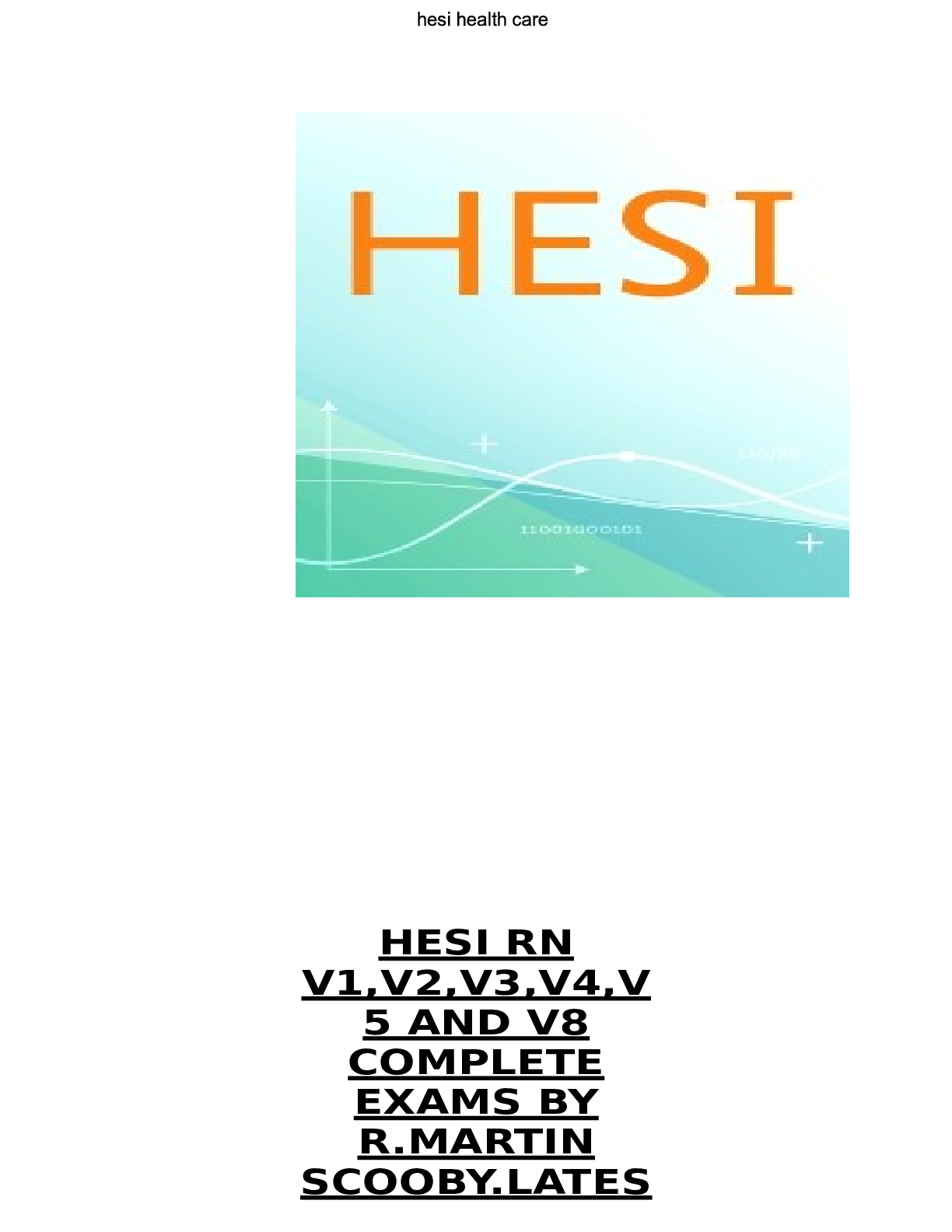
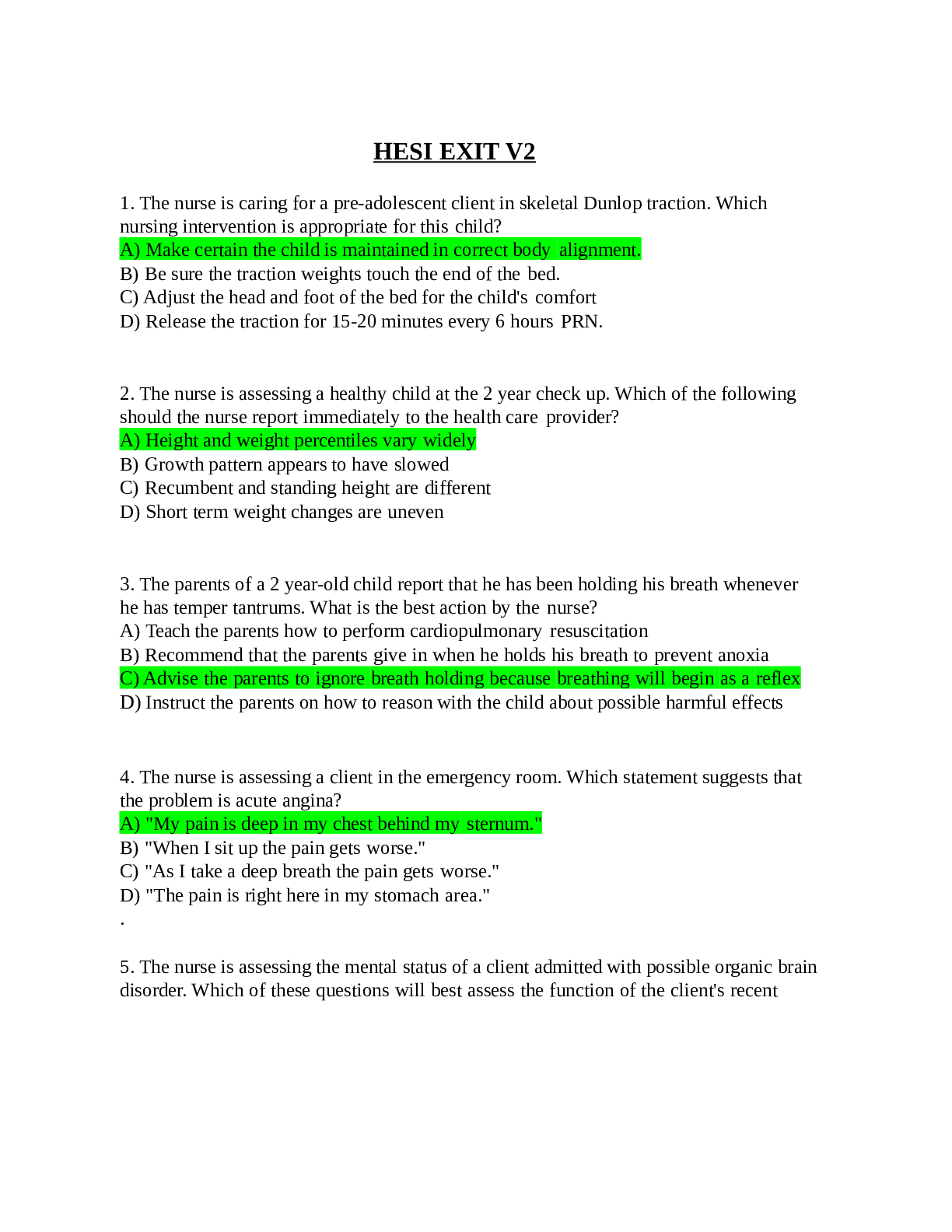
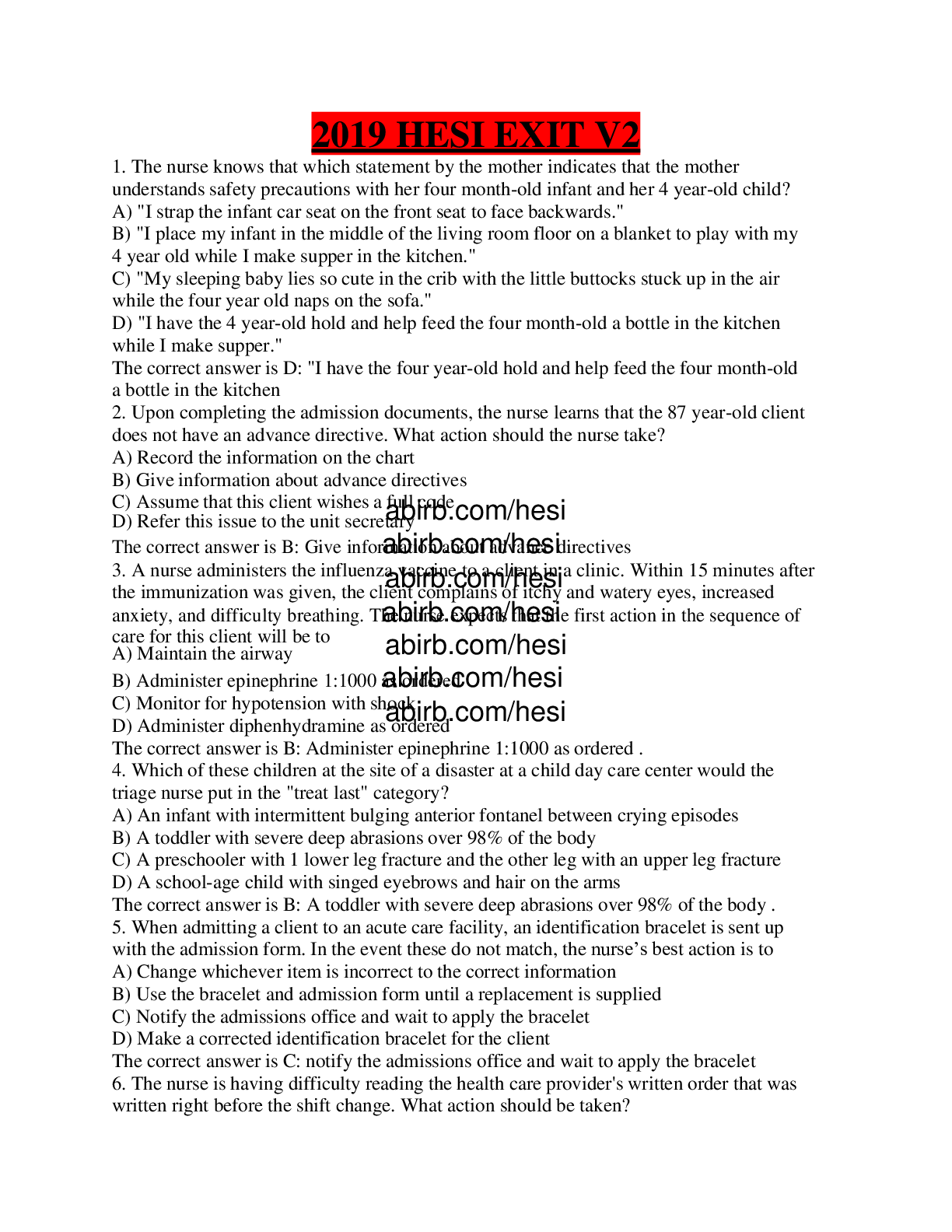
.png)
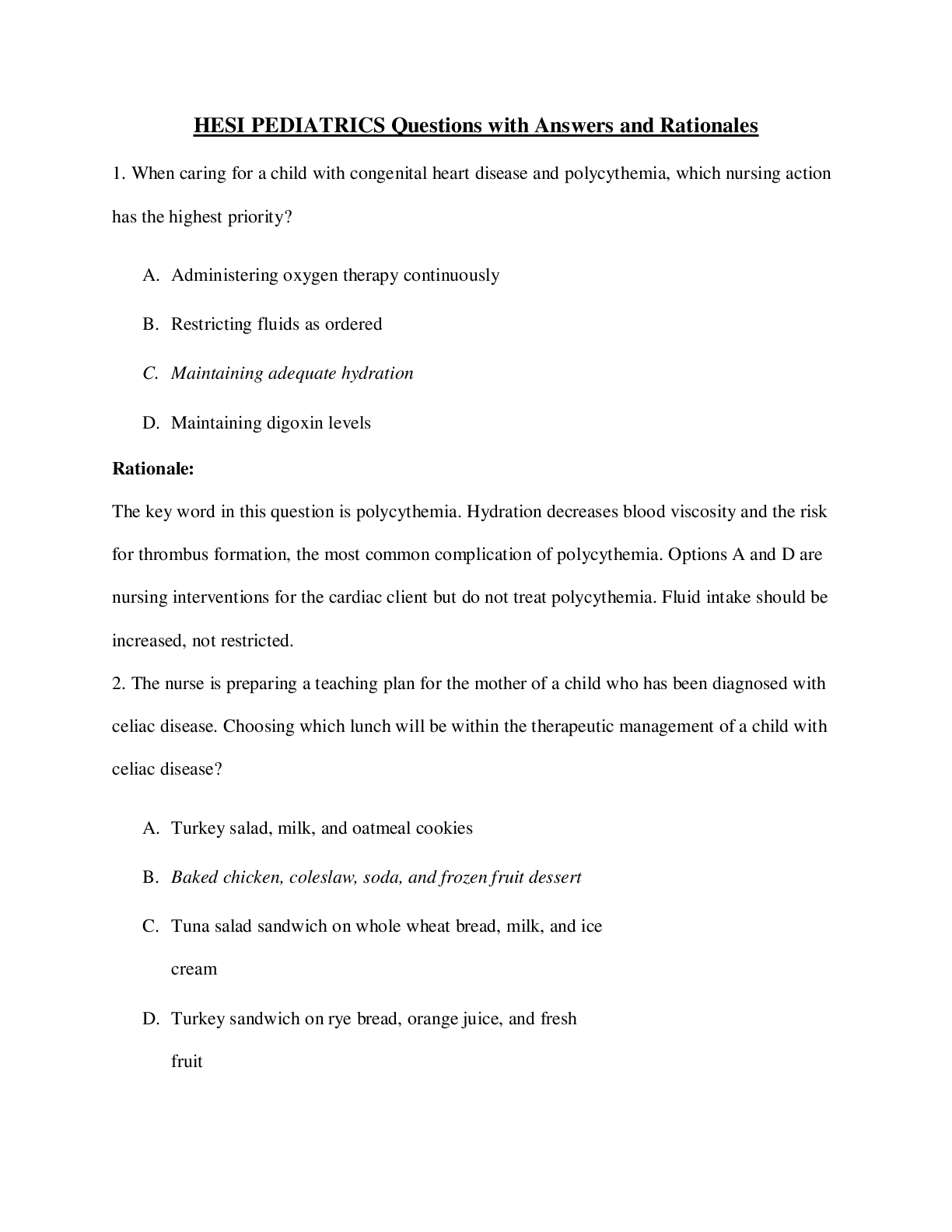
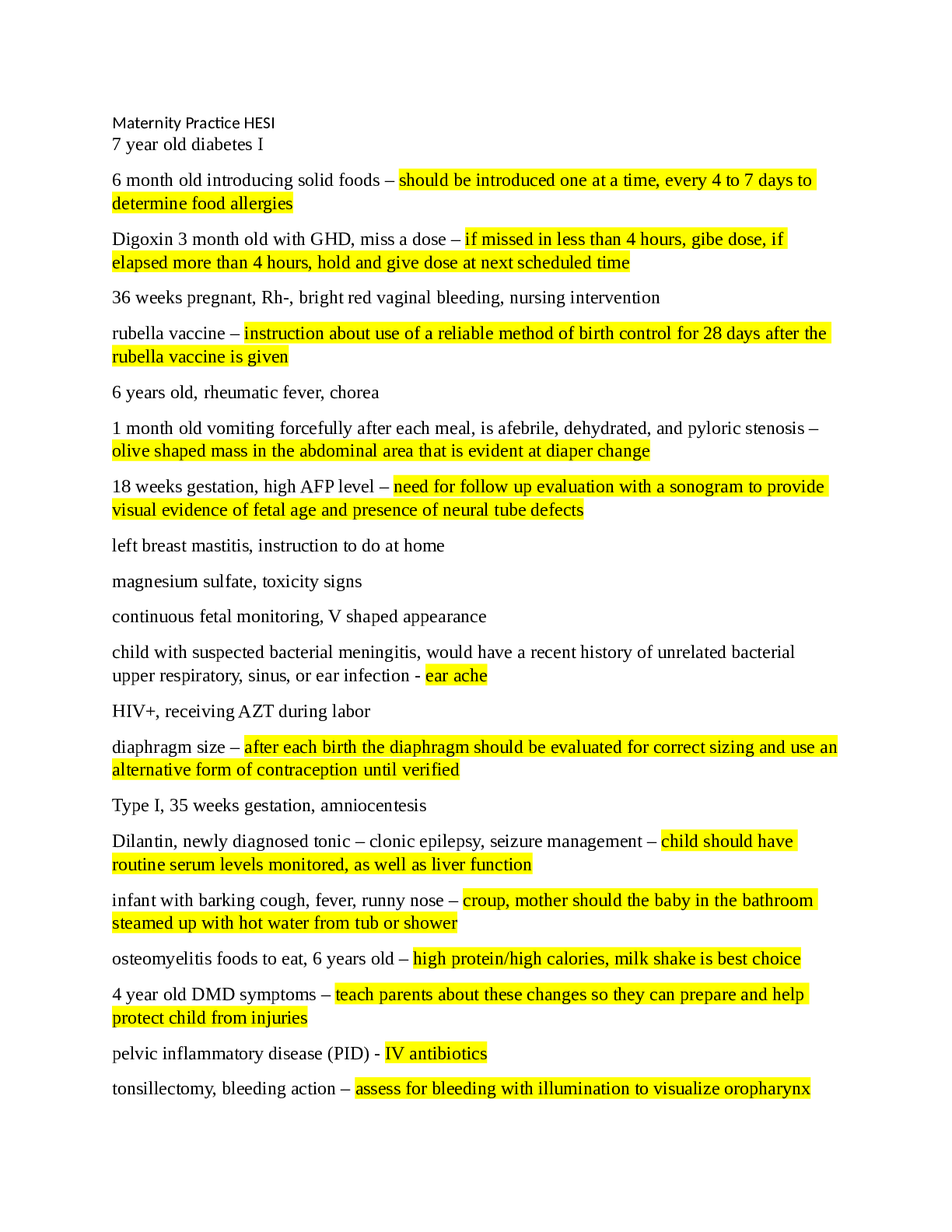

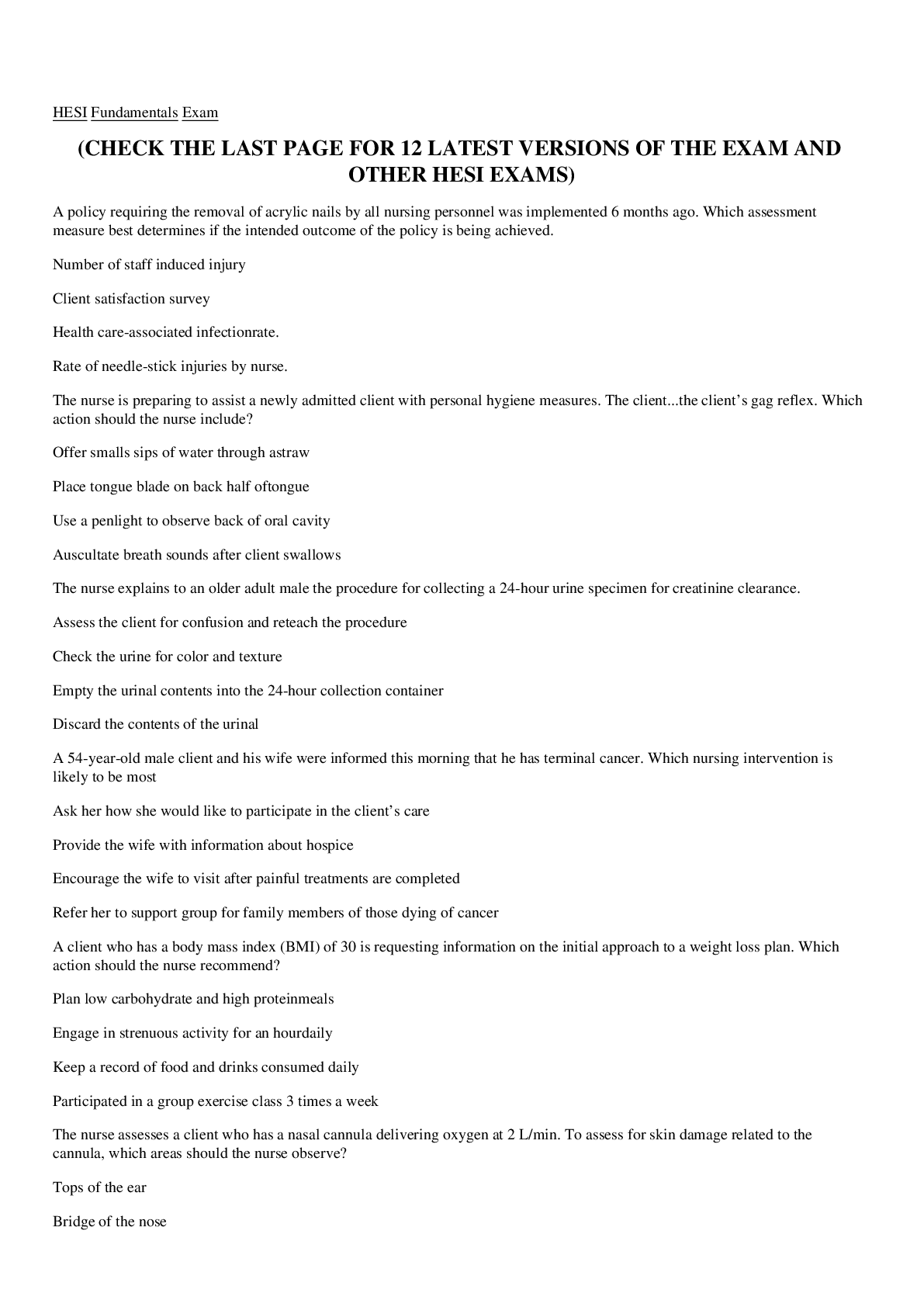

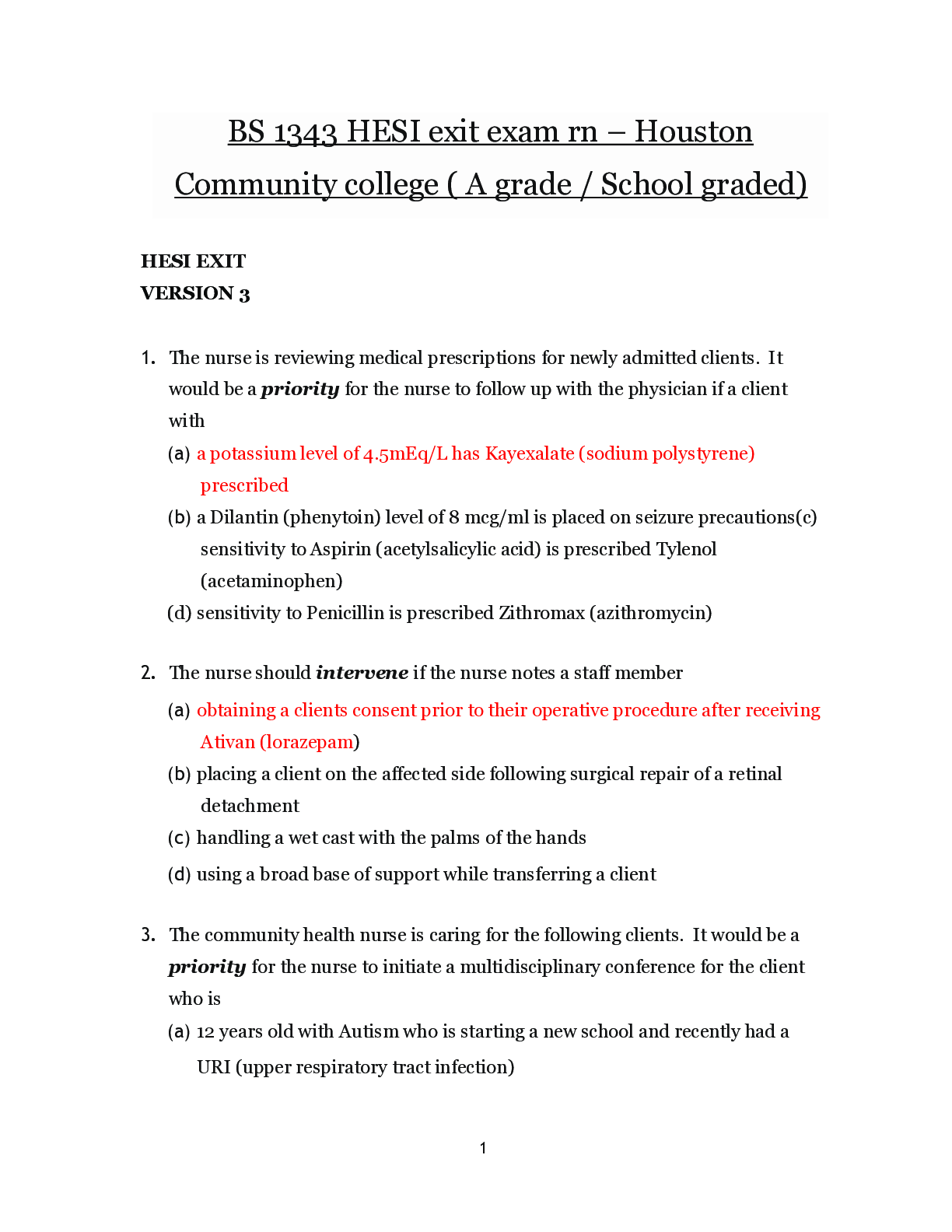
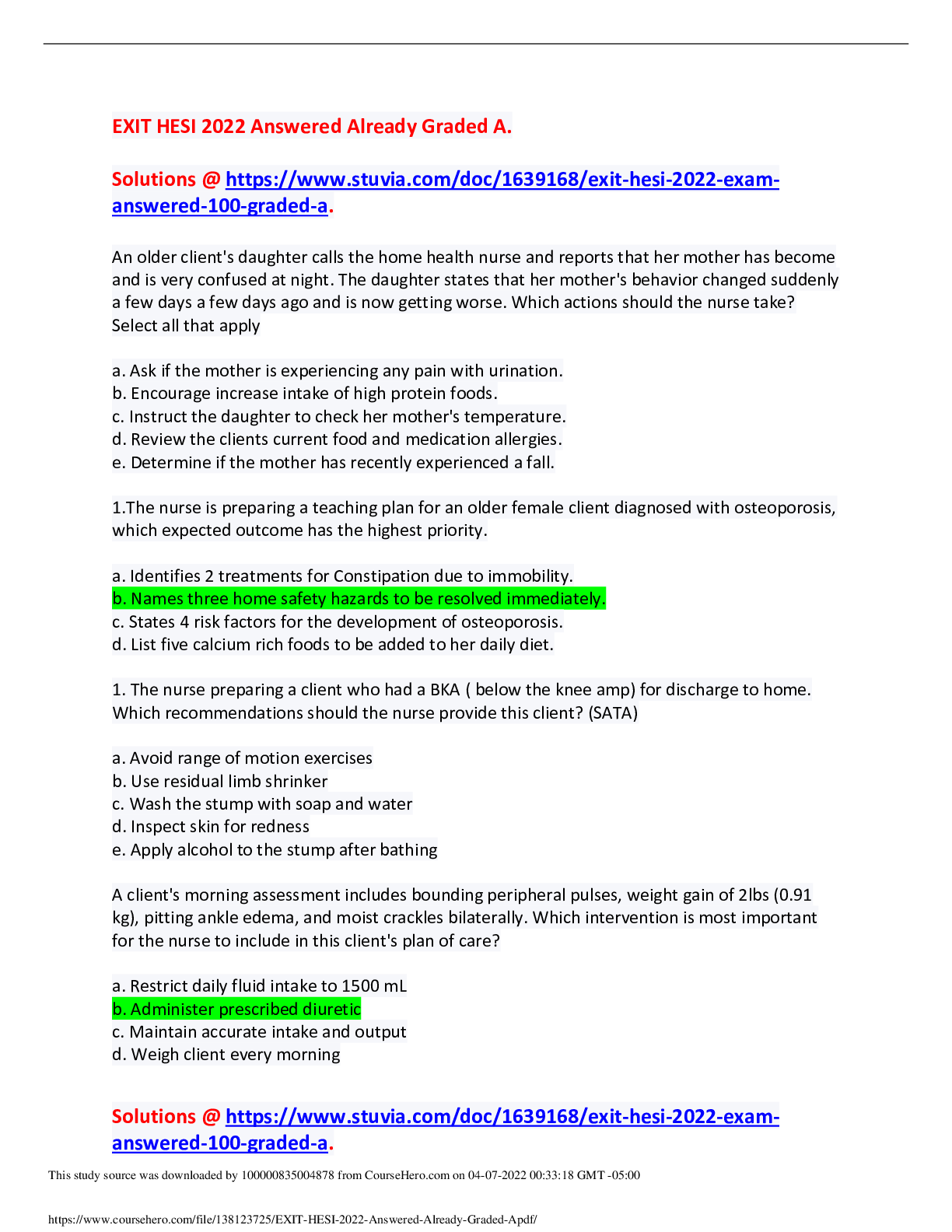


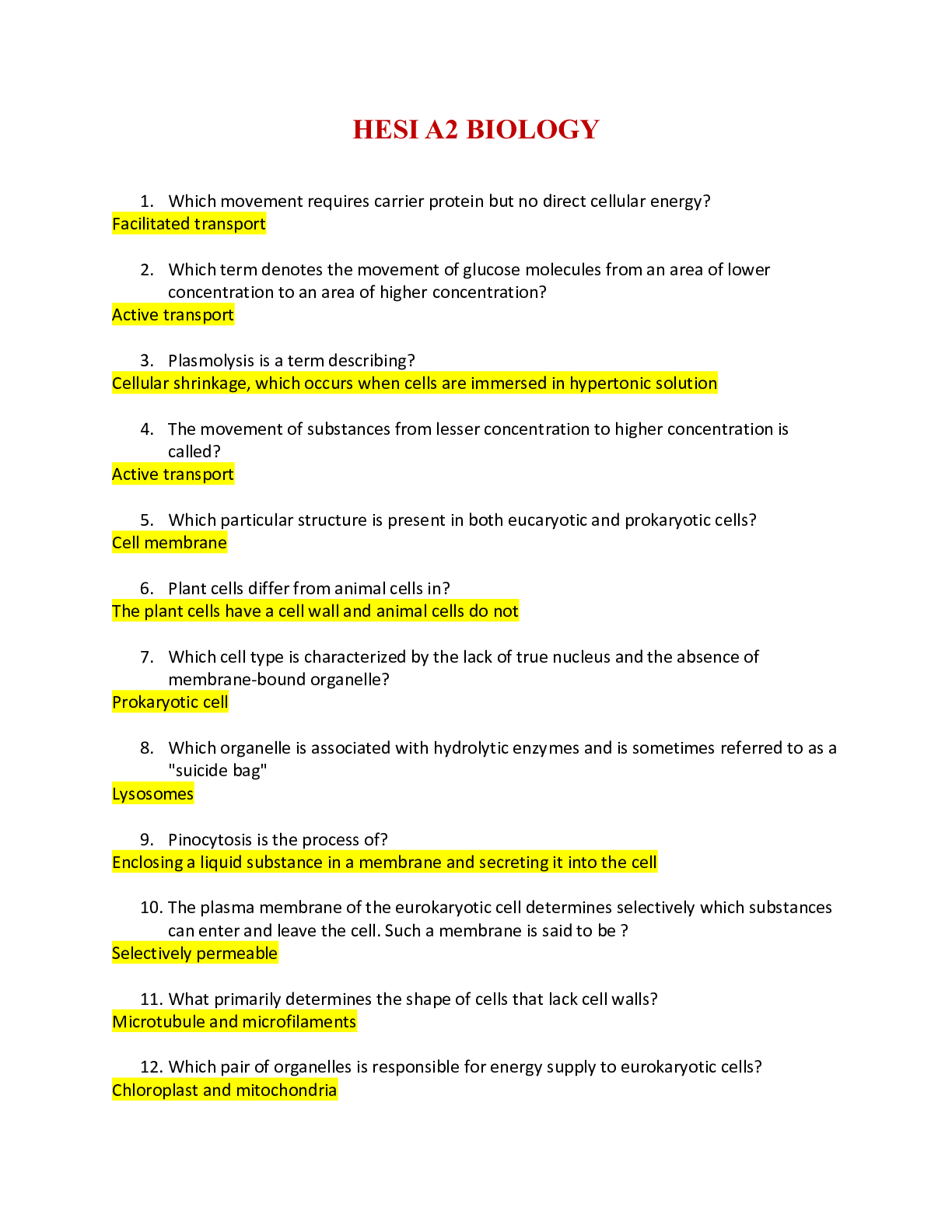
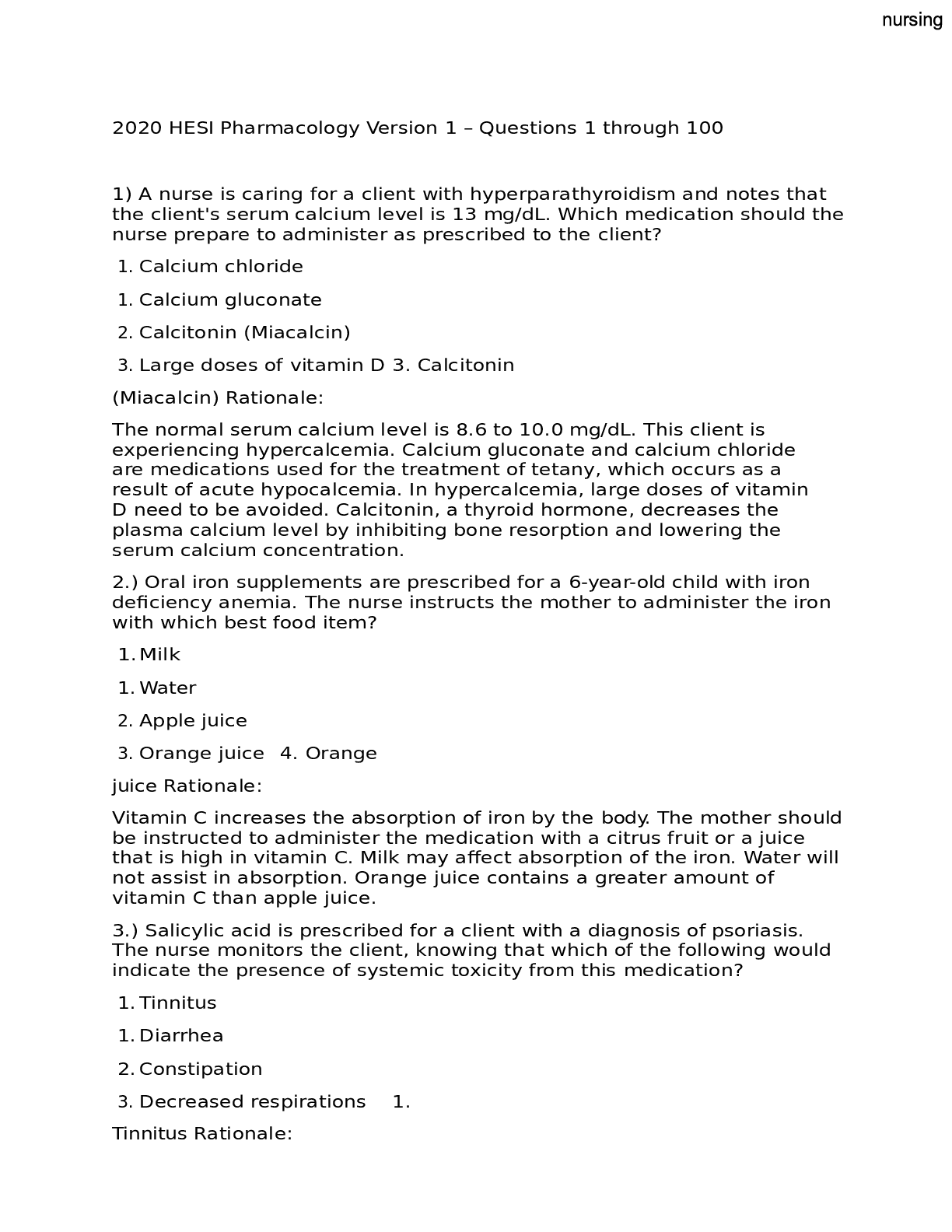
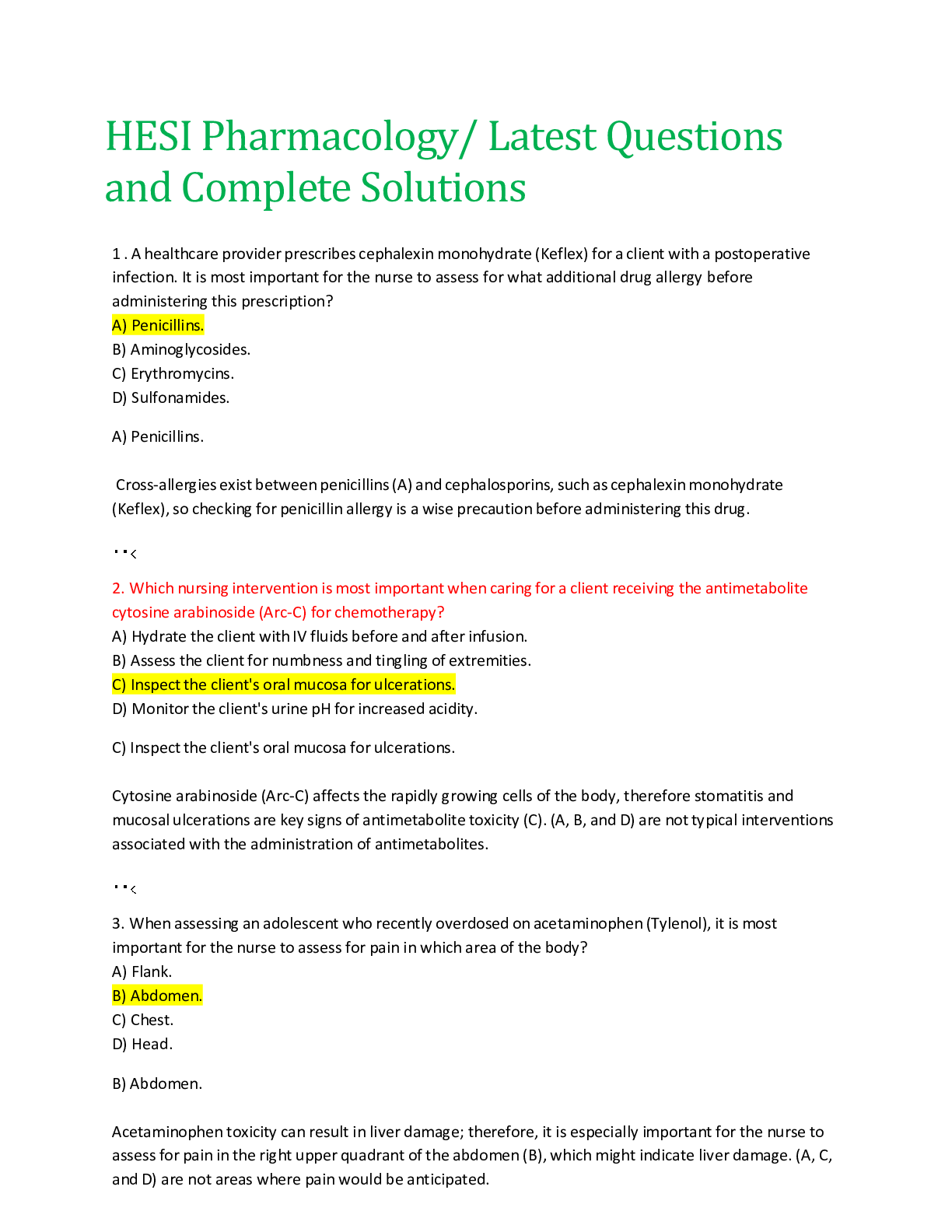
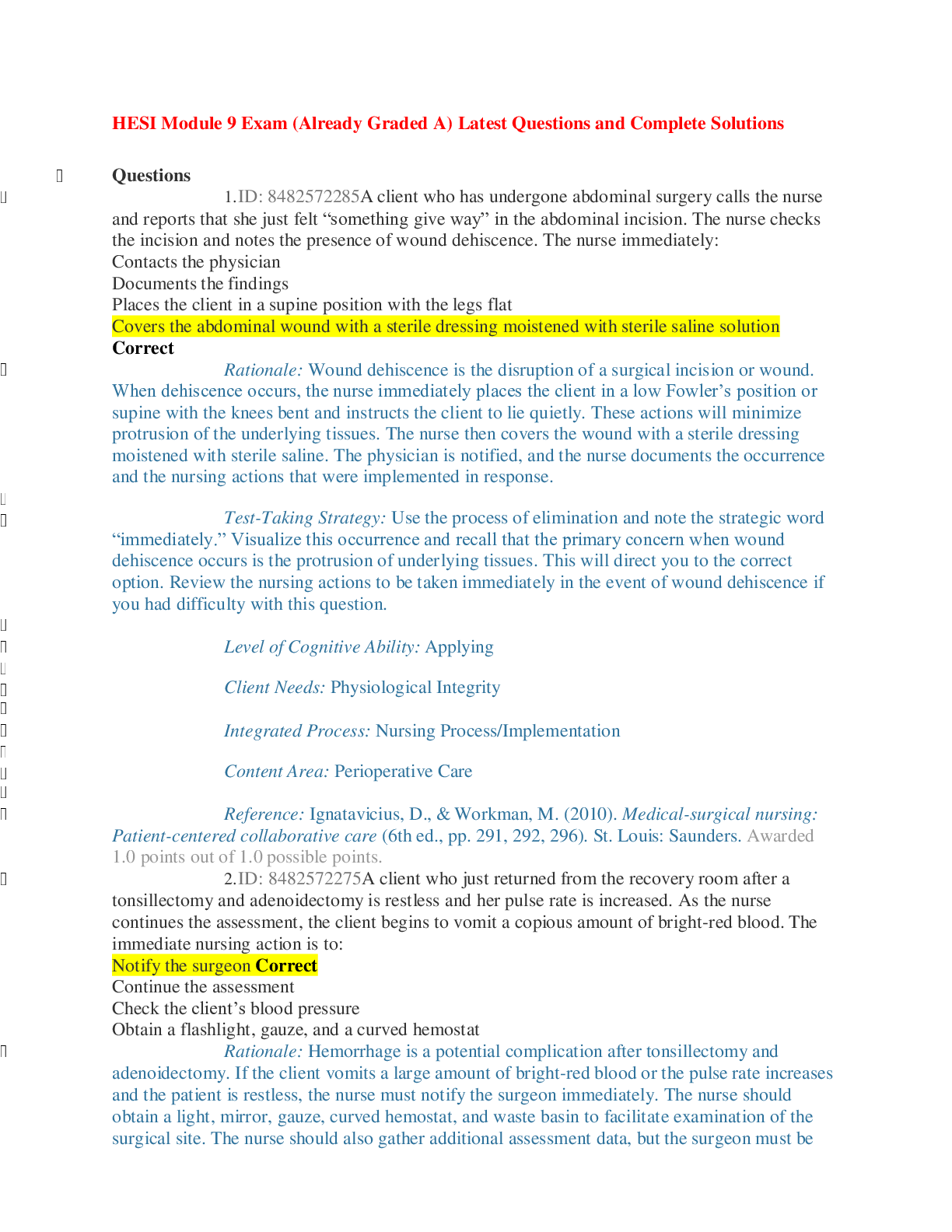
 Latest Questions and Complete Solutions.png)
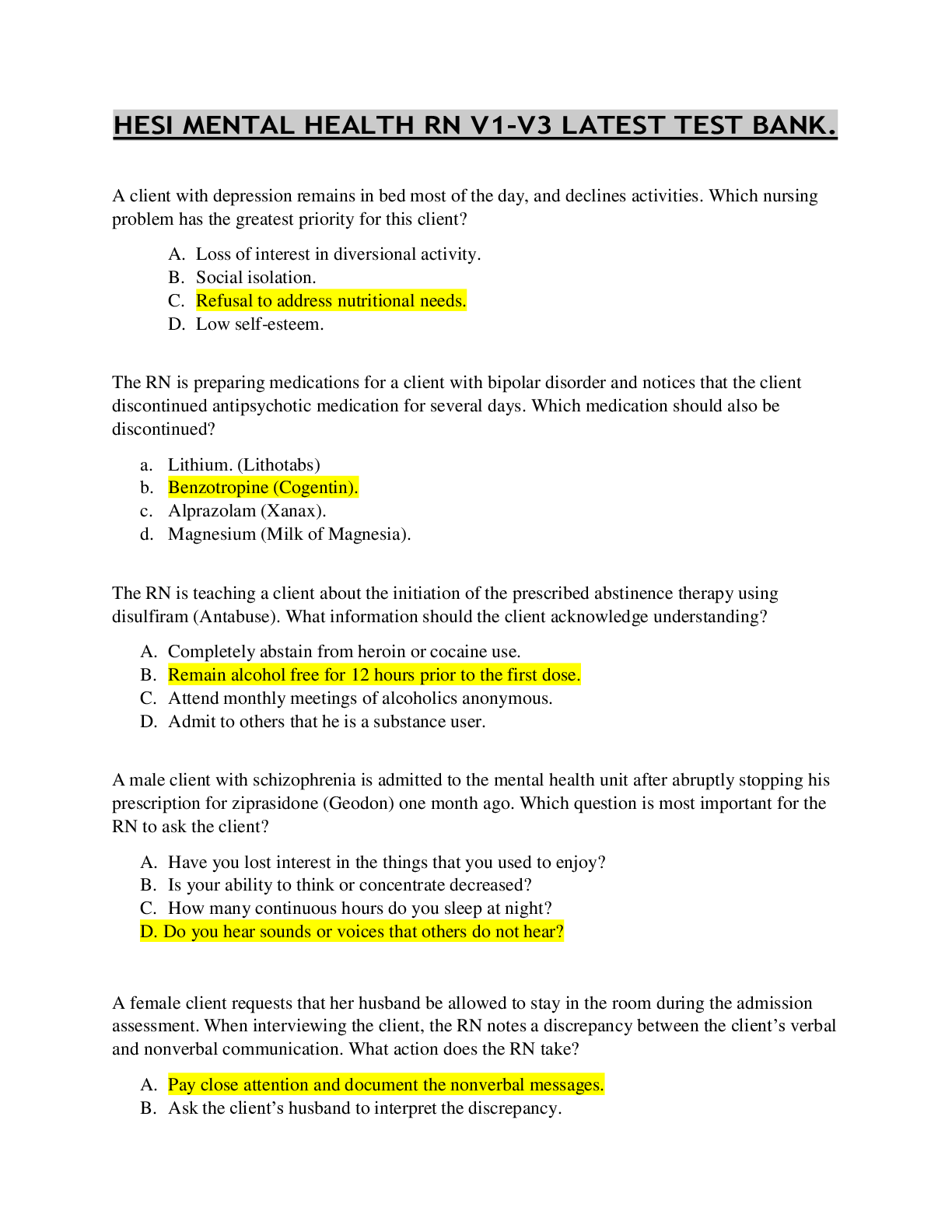
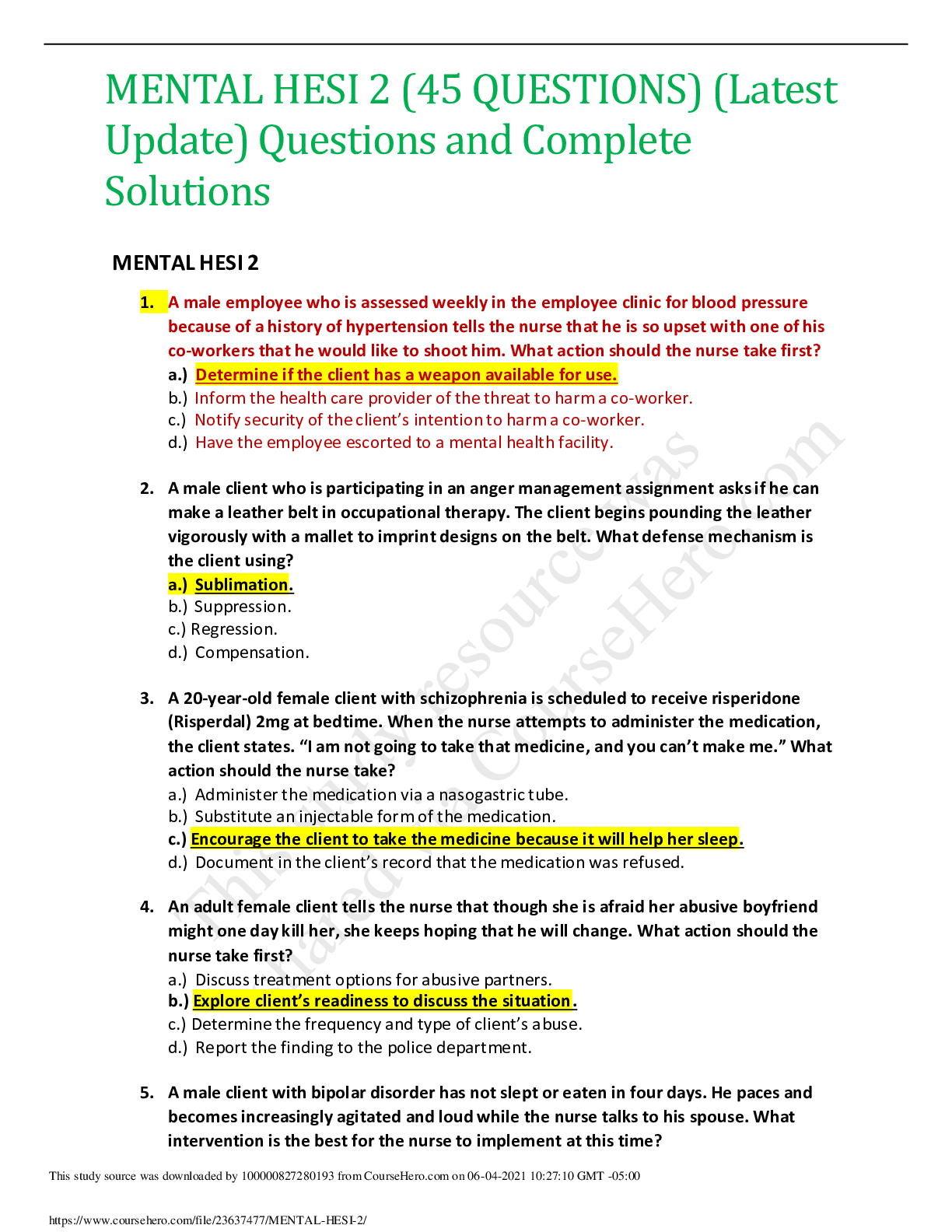
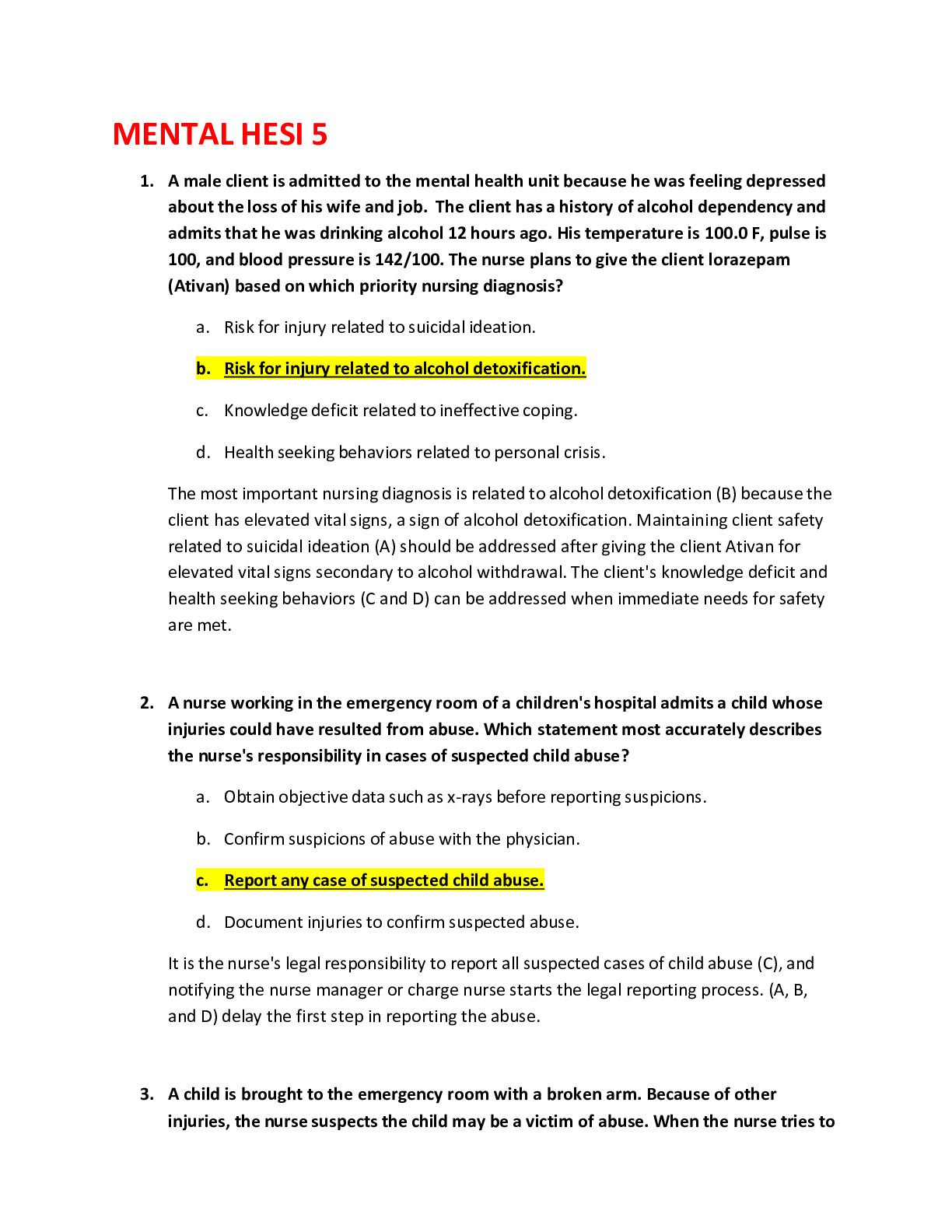
 (1).png)

